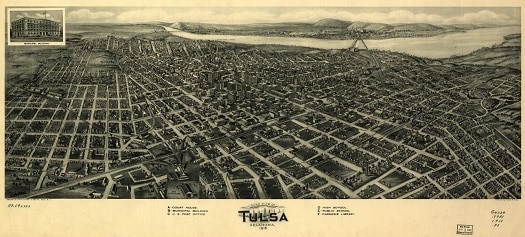
Featured Image from Library of Congress
The Greenwood District of Tulsa, Oklahoma, also known as “Black Wall Street”, was once a shining example of African-American success within the United States. Throughout this district, African-American businesses, homeowners, and settlers thrived. It was a place of cultural and ethnic representation that was unique to its small pocket of Tulsa.
On May 31, 1921 all of that changed as houses, business, and streets were set aflame by masses of white-surpremacists. In what has now become known as one of the worst acts of racial terrorism since the age of slavery, the Greenwood District would cease to exist, at least in the way people once knew it. Over 300 individuals were killed, 6,000 or more left homeless and without a means of income, and millions of dollars of property damage was the scar left on “Black Wall Street.” Unfortunately, this event has been forgotten by history – likely in an attempt to cover up an embarrassing scar of US History.
Assignment: Using this background information, along with the documents (photos, redline map, and newspapers) provided, piece together the events of the Tulsa Race Massacre and how they occurred. Investigate what events transpired to cause the riots. Once you have investigated these causes, attempt to answer the essential questions provided.
Essential Question: In what way(s) is the Tulsa Race Massacre representative of US History?
Bonus Question: Why was this event recognized by Congress in 2020, nearly 100 years after the massacre?

The red district is Greenwood
Question for Map: What do you notice about the Greenwood district? What surrounds it? Is it reasonable to assume why this neighborhood would have been attacked based on its redlining desirability rating?
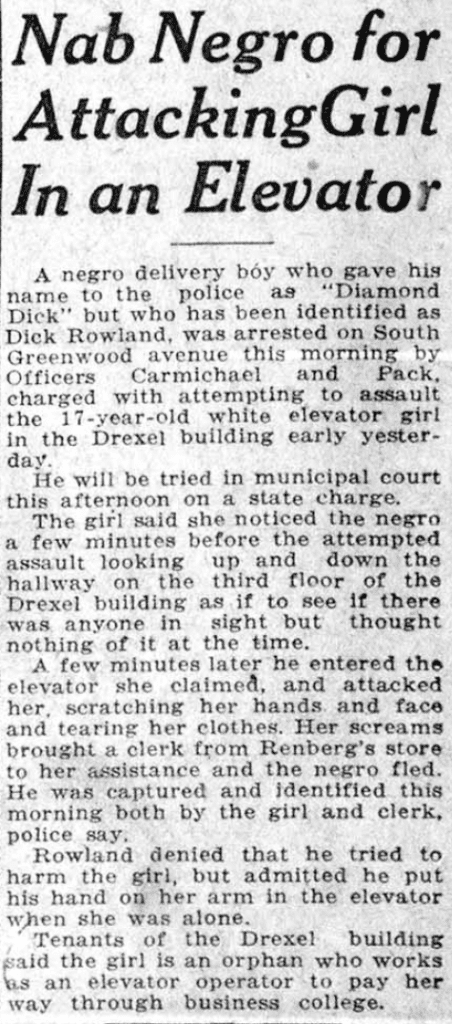
Question for Article: In what way was this story misconstrued to fit a certain narrative?
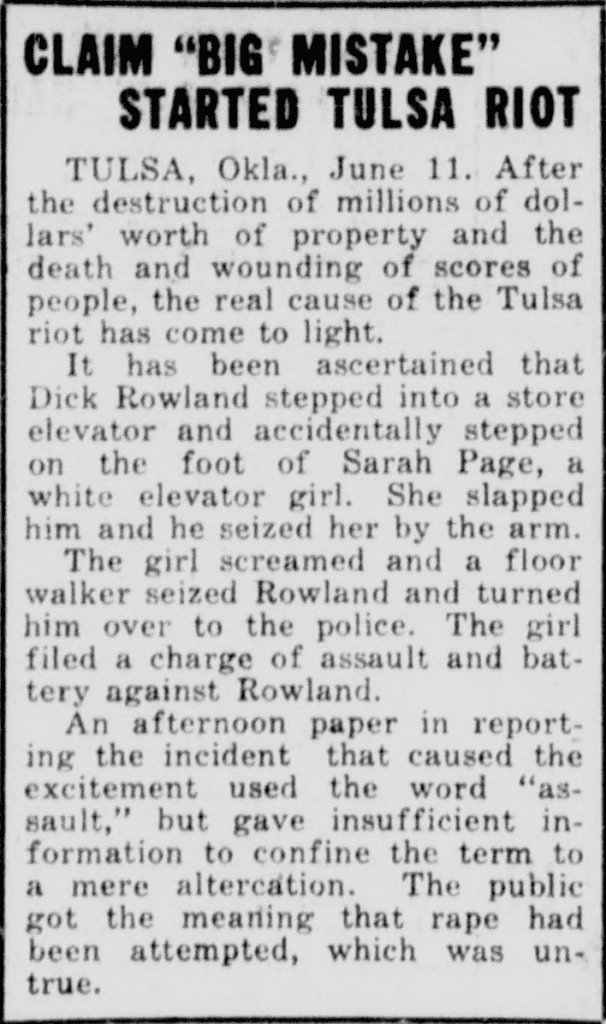
Question for Article: How does the article about the massacre differ from the last newspaper? Was the massacre downplayed?
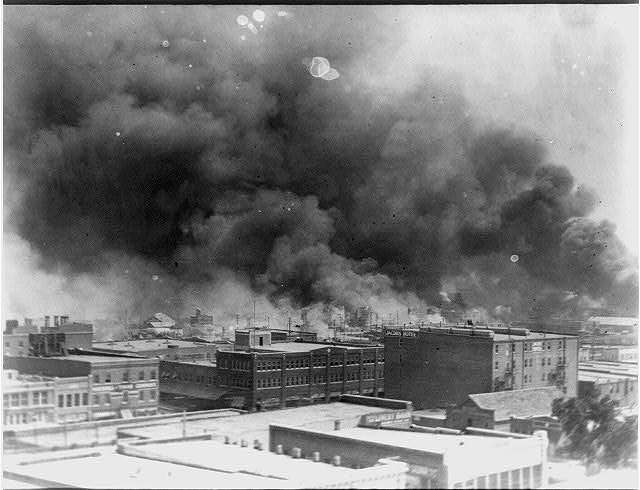
Question for Photo: What was the point of burning business rather than just attacking people in Greenwood?

Question for Photo: Why was this furniture found in the streets? Who did it belong to?
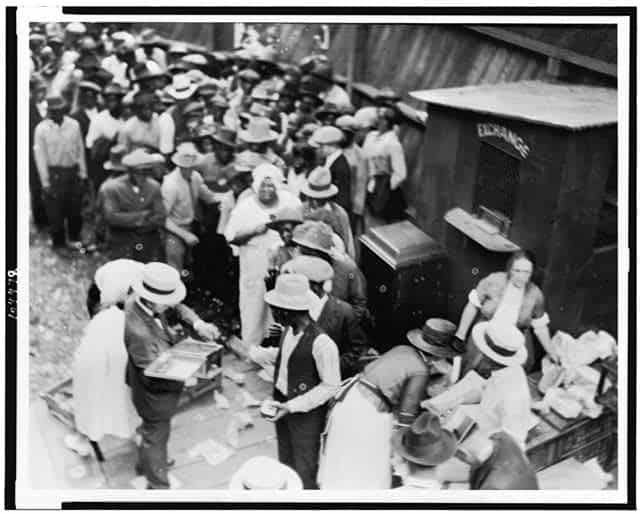
Question for Photo: What was the predominant demographic of the food distribution following the massacre? What does this tell you about the population of Greenwood?

Transcript of Congressional Resolution:
“This resolution recognizes the forthcoming centennial of the Tulsa Race Massacre of 1921.
The resolution, among other things
- acknowledges the historical significance of this event as one of the largest single instances of state-sanctioned violence against black people in American history;
- honors the lives and legacies of the estimated 300 black individuals who were killed during the massacre and the nearly 9,000 who were left homeless and penniless;
- condemns efforts to cover up the truth and shield the white community, especially government officials, from accountability;
- condemns the continued legacy of racism and white supremacy against black people in the United States, particularly in the form of police brutality;
- encourages education about the massacre, the history of white supremacy that fueled the massacre, and subsequent attempts to deny or cover up the massacre, in all elementary and secondary education settings and in institutions of higher education; and
- recognizes the commitment of Congress to acknowledge and learn from the history of racism and racial violence to reverse the legacy of white supremacy and fight for racial justice.”
Question for Resolution: Has our perception of the event changed? If so, what has caused these changes?
Sample Answers for Questions:
- The Greenwood district is in a red district that is entirely surrounded by green and blue districts. It makes sense that this would have been a red district back then, as it was mostly where POC lived, and it also makes sense why they would have attacked it. If it was surrounded by blue and green, getting rid of the demographic that is bringing down the rest of the area seems like an effective means of increasing the property value of the areas around it, provided the history of the massacre was covered up.
- The girl was clearly playing the victim card in order to make the delivery boy seem like a hostile attacker. He was clearly just doing his job and accidentally bumped into the girl. Whether it was to get her college paid for or to start something with the African-American community, there were clearly ulterior motives for her story that wouldn’t have existed otherwise.
- The story about the delivery boy was talked about as if it were an accident, which is only noteworthy because prior to the riots, they had published the newspaper article calling him a “Negro” and accusing him of attacking the girl. The massacre was heavily downplayed in the article because they just call it a riot, instead of a race driven attack.
- Destroying the buildings creates generational struggles, while attacking people creates individual struggles. If you destroy the livelihood of one generation, the next generation will struggle even more significantly to get back on their feet. All of the wealth they had accumulated would be gone, and the motivation of those affected would change from striving for success to striving for survival.
- The furniture was found in the street. It is likely whatever survived from peoples’ homes when they went up in flames during the riots. Therefore, the furniture belonged to the residents of the Greenwood district.
- The predominant demographic was African-American because their homes, business, and livelihoods were destroyed as a result of the race riot. Most of these people had no money, and no means of making money, forcing them to use the food distribution lines.
- Our perception of the event has changed significantly over time. There was a period of time where the attack was considered a tragedy, but likely no one was at fault. Nowadays, it is clear who was at fault, and it clearly had nothing to do with the thriving African-Americans of the Greenwood district. Even if the delivery boy did assault the girl, that was no excuse to burn down an entire district of POC. It was a clear disregard for human lives where many people died, and many more were left to suffer. It was a tragedy, but not one that is without blame. The reason our perception has changed so much is because we are starting to not shy away from learning the ugly parts of our nations’ history. Instead of acting like they didn’t happen, we are choosing to learn from these events rather than acting like they didn’t happen. Legislation and national recognition are following the fact that more and more people are learning about these events. We need to continue to learn about our history, otherwise people will continue to be affected the way the residents of the Greenwood district were, and nobody will be held accountable. We learn about these things so we know how to react to them when they inevitably happen again.

Chris, this is an impressive lesson. You have curated an interesting and varied collection of source material. Good guiding questions and suggested answers.
I like that you thought to build on our redlining work and include that data in the lesson. The proximity of the more desirable “green” and “blue” districts speaks so much about underlying motivation for the massacre. (Although I think you might want to include a brief explainer about redline maps. Even just a link to our previous lesson would give a reader the necessary background.)
The “competing” newspaper accounts expand the story and add yet another layer.
A well designed lesson that firmly anchors the historical events in the recent Congressional resolution. That affirms the importance of who get to write history and “how the word is passed.”
Chris, this is great piece! Its a chapter of American history that we don’t hear enough about. I thought you mix of different media and documents was great. It didn’t depend on one type too much.